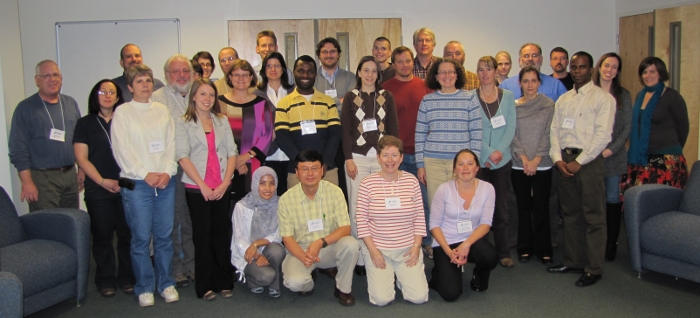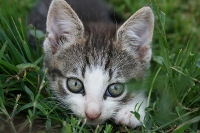| Description | Participants | Agenda | Summary | Presentations | Products |
|---|
NIMBioS Investigative Workshop
Free-roaming Cats and Rabies

Topic: Modeling Free-roaming Cat Population Dynamics through the Lens of a Rabies Model
Meeting dates: November 9-11, 2011
Location: NIMBioS at the University of Tennessee, Knoxville
Organizers:
Margaret R. Slater, American Society for the Prevention of Cruelty to Animals, Shelter Research and Development, Urbana Il (Biology)
Yang Kuang, Arizona State University, School of Mathematical and Statistical Sciences, Tempe, AZ (Mathematics)
Objectives: Cats are the most popular companion animal in the U.S. with more than 81 million living in our homes. Between 32 to 53 million cats are estimated to roam freely in the U.S. The population dynamics of free-roaming cats (FRC) and the ways in which they transmit infectious disease are not fully understood. Concerns about the health of FRCs themselves, zoonotic disease transmission, transmission of diseases to other non-human species, predation on native wildlife species and nuisance complaints are common. Our first step is to identify existing data sources and critical data gaps relating to FRC population dynamics and rabies transmission. Our second step is to review and consider the strengths and weaknesses of the different types of modeling approaches (mathematical, systems, statistical, simulation) using the expertise of our participants.
Better data to inform policy makers, particularly relative to public health issues, would be invaluable. Expanding our understanding of modeling FRC populations would allow for a much more efficient and practical approach to decreasing the size of potentially problematic FRC populations, thus reducing issues relating to too many cats as well as the risk of rabies transmission. This problem requires a multidisciplinary tactic as well as the need for creative, synergistic thinking to identify preferred approaches. The workshop will bring together a unique group of experts across a number of biological and mathematical disciplines with varying experiences and contacts to develop priorities and future plans.
The Workshop will include presentations about existing modeling efforts and data for FRC, different model types that could be applied to FRC populations and rabies control and issues specific to modeling FRC. Breakout discussion sessions will focus on identifying additional sources of data that may be useful as well as critical data gaps, models that show promise for use in FRC basic population dynamics and those that can be used for rabies. Finally, discussion sessions to prioritize future directions including consensus on model approaches and formalize collaborations will be held.
 Summary Report.
The meeting began with presentations to bring all participants to a better understanding of free-roaming cat (FRC) lifestyles, vital rates and quirks as well as rabies transmission factors and mechanisms, and modeling. SEIR models and several variations, simulation models, network analysis were all presented and discussed. These activities provided everyone with a chance to reach a common level of general understanding of the issues from the mathematics and biology perspectives and for the group to begin to work together. A general consensus was reached that there are many difference modeling approaches that might prove useful but that a good FRC population dynamics model was needed before adding the complexity of any disease. For rabies in cats, spill over from the wildlife population is the source and our concerns are for the possible exposure and/or transmission from cats to humans. The workshop identified the following series of topics of interest to more than one person for continued conversations and possible collaborations:
Summary Report.
The meeting began with presentations to bring all participants to a better understanding of free-roaming cat (FRC) lifestyles, vital rates and quirks as well as rabies transmission factors and mechanisms, and modeling. SEIR models and several variations, simulation models, network analysis were all presented and discussed. These activities provided everyone with a chance to reach a common level of general understanding of the issues from the mathematics and biology perspectives and for the group to begin to work together. A general consensus was reached that there are many difference modeling approaches that might prove useful but that a good FRC population dynamics model was needed before adding the complexity of any disease. For rabies in cats, spill over from the wildlife population is the source and our concerns are for the possible exposure and/or transmission from cats to humans. The workshop identified the following series of topics of interest to more than one person for continued conversations and possible collaborations:
- The FRC population dynamics modeling piece to get a better handle on what we already can do
- A comprehensive literature review with collaboration between the University of Nottingham and the Alliance for Contraception in Cats and Dogs
- The CDC dog immunocontraception project possibly in combination with rabies vaccine, possibly oral
- Cat field work as needed to answer questions relating to the population modeling. Also the development of methods to use existing data to help evaluate success of sterilization or change in FRC populations
- Contraception and infection susceptibility
- Finding better ways to work with cat caretakers and get data from them
- Finding out what work on rabies typing is currently happening at the CDC for better insight regarding what species are infecting cats
- Adding modeling to the Flagstaff, AZ rabies studies
- Identifying and analyzing existing sources of field data on cats, primarily as “accidental” trapping in wildlife surveillance studies
- Looking more theoretically at modeling the population density of FRC and related issues
Products
Publications
Miller PS, Boone JD, Briggs JR, Lawler DF, Levy JK, Nutter FB, Slater M, Zawistowski S. 2014. Simulating free-roaming cat population management options in open demographic environments. PLoS ONE, 9(11). [Online]
Borchering RK, Liu H, Steinhaus MC, Gardner CL, Kuang Y. 2012. A simple spatiotemporal rabies model for skunk and bat interaction in northeast Texas. Journal of Theoretical Biology, 314: 16-22. [Online]
Presentations
Boone J. 20-22 June 2013. From data to implementation: Using modeling results and field studies to generate management guidance for free-roaming cats. 5th International Symposium on Non-Surgical Contraceptive Methods of Pet Population Control, Alliance for Contraception in Cats and Dogs, Portland, OR. [Online]
Slater M. 20-22 June 2013. Counting cats: Some guidance and an example. 5th International Symposium on Non-Surgical Contraceptive Methods of Pet Population Control, Alliance for Contraception in Cats and Dogs, Portland, OR. [Online]
Zawistowski S. 20-22 June 2013. Focus on felines: Tools to help you plan your programs and measure your success. 5th International Symposium on Non-Surgical Contraceptive Methods of Pet Population Control, Alliance for Contraception in Cats and Dogs, Portland, OR. [Online]
Zawistowski S, Miller P, Boone J, Lawler D, Slater M, Levy J, Nutter F, Briggs J. November 2013. Simulating different approaches for managing free-roaming cat populations. National Council on Pet Population and Society of Animal Welfare Administrators Research Symposium, Tempe, AZ.
Boone JD. December 2012. Adaptive management for free-ranging cats. The Outdoor Cat: Science and Policy from a Global Perspective, Humane Society of the United States, Marina Del Ray, CA.
Boone JD. October 2012. A vision for more effective management of free-ranging cats. ACC&D Stakeholders Meetings, Las Vegas, NV.
Miller P. October 2012. Free-roaming cat population dynamics: A simulation modeling project update. Alliance for Contraception in Cats and Dogs, Stakeholder Meeting, Las Vegas, NV.
Grants & Proposals
Slater S, Zawistowski S, Boone J, Miller P, Levy J, Lawler D. 2012. Alliance for Contraception in Cats and Dogs. Evaluating management alternatives for free-roaming cat populations across a range of landscapes: An individual-based, demographic simulation modeling approach. ASPCA. $45,000. Accepted.
Software, Data, and/or Website
Boone J, Slater M. 2013. A generalized population monitoring program to inform the management of free-roaming cats. [Online]
Miller P, ACC&D Cat Population Model Working Group. March 2013. Completed simulation model of free-ranging cat populations and multiple management scenarios, and accompanying report. ACC&D and the ASPCA (submitted).
NIMBioS Investigative Workshops focus on broad topics or a set of related topics, summarizing/synthesizing the state of the art and identifying future directions. Workshops have up to 35 participants. Organizers and key invited researchers make up half the participants; the remaining participants are filled through open application from the scientific community. Open applicants selected to attend are notified by NIMBioS within two weeks of the application deadline. Investigative Workshops have the potential for leading to one or more future Working Groups. Individuals with a strong interest in the topic, including post-docs and graduate students, are encouraged to apply. If needed, NIMBioS can provide support (travel, meals, lodging) for Workshop attendees, whether from a non-profit or for-profit organization.
A goal of NIMBioS is to enhance the cadre of researchers capable of interdisciplinary efforts across mathematics and biology. As part of this goal, NIMBioS is committed to promoting diversity in all its activities. Diversity is considered in all its aspects, social and scientific, including gender, ethnicity, scientific field, career stage, geography and type of home institution. Questions regarding diversity issues should be directed to diversity@nimbios.org. You can read more about our Diversity Plan on our NIMBioS Policies web page. The NIMBioS building is fully handicapped accessible.
NIMBioS
1122 Volunteer Blvd., Suite 106
University of Tennessee
Knoxville,
TN 37996-3410
PH: (865) 974-9334
FAX: (865) 974-9461
Contact NIMBioS


